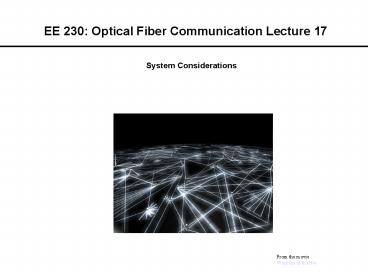EE 230: Optical Fiber Communication Lecture 17 - PowerPoint PPT Presentation
1 / 25
Title:
EE 230: Optical Fiber Communication Lecture 17
Description:
... one can replace PIN photodiode with APD add an EDFA to the link Power Budget Example Risetime Budget Rise time budget components bit rate and coding format ... – PowerPoint PPT presentation
Number of Views:154
Avg rating:3.0/5.0
Title: EE 230: Optical Fiber Communication Lecture 17
1
EE 230 Optical Fiber Communication Lecture 17
System Considerations
From the movie Warriors of the Net
2
Basic Network Topologies
3
Bitrate Distance Graph for various point to point
link technologies
4
System Design
- Determine wavelength, link distance, and
bit-error rate - Work out power budget
- Work out risetime budget
- Work out cost budget
5
Power Budget Steps
- Start with BER and bit rate, determine B based on
coding method - B 1/2?RC gives the maximum load resistance R
based on B and C - Based on R and M, determine detector sensitivity
(NEP), multiply by B1/2 - Add system margin, typically 6 dB, to determine
necessary power at receiver
6
Power budget steps, continued
- Add power penalties, if necessary, for extinction
ratio, intensity noise (includes S/N degradation
by amplifiers), timing jitter - Add loss of fiber based on link distance
- Include loss contributions from connections and
splices - End up with required power of transmitter, or
maximum length of fiber for a given transmitter
power
7
Power budget example
- Imagine we want to set up a link operating at
1550 nm with a bit rate of 1 Gb/s using the RZ
format and a BER of 10-9. We want to use a PIN
photodiode, which at this wavelength should be
InGaAs. The R0 for the diode is 0.9 A/W.
8
Bandwidth required for bit rate
- For NRZ format, B0.5 times bit rate
- For RZ format, Bbit rate
- For this example, the bandwidth B is equal to the
bit rate, 109 /s.
9
Bandwidth limit
- C2 pF for this photodiode.
- B 1/2?RC, so the load resistance R must be
(2?BC)-1 79.6 ?
10
Noise Equivalent Power (NEP)
- Signal power where S/N1
- Units are W/Hz1/2
- In this case, M1 and the dark current 4 nA.
- The factor outside the radical is 1/R0. We can
thus determine the NEP, which is 5.1x10-7 W,
which equals -33.0 dBm.
11
Q Factor and BER
- For our BER of 10-9, Q6 and S/N12
12
Extinction ratio penalty
- Extinction ratio rexP0/P1
- If our extinction ratio is 0.1, the penalty is
0.87 dB.
13
Intensity noise penalty
- rIinverse of SNR of transmitted light
- Since our S/N is 12, rI0.83, which leads to a
power penalty of 1.25 dB
14
Timing jitter penalty
- Parameter B?fraction of bit period over which
apparent clock time varies - If our jitter represents 10 of the bit period,
the power penalty is 0.34 dB
15
Fiber attenuation
- If the attenuation in the fiber is 0.2 dB/km and
the link is 80 km long, the total loss in the
fiber will be 16.0 dB
16
Example results
- Minimum power required for receiver
- -33.0 dBm
- Safety margin 6.0 dB
- Extinction ratio power penalty 0.87 dB
- S/N power penalty 1.25 dB
- Timing jitter power penalty 0.34 dB
- Fiber loss over 80 km 16.0 dB
- Total minimum transmitter power
- -8.54 dBm0.14 mW140 ?W
17
Further steps
- Alternatively, previous data could be used with a
fixed transmitter power to determine maximum
length of a fiber link - If power budget does not add up, one can
- replace PIN photodiode with APD
- add an EDFA to the link
18
Power Budget Example
19
Risetime Budget
20
Rise time budget components
- bit rate and coding format determine upper limit
of rise time - rise time of transmitter (from manufacturer
laser faster than LED) - pulse spread due to dispersion
- rise time of receiver (from manufacturer PIN
faster than APD) - Rise time components are combined by taking the
square root of sums of squares
21
Upper limit for rise time
- For NRZ format, Tr0.70/B
- For RZ format, Tr0.35/B
- In this case, choose RZ format. Tr must thus be
less than or equal to 0.35/109 350 ps
22
Group Velocity Dispersion-based rise time
- Calculate from laser optical bandwidth if known,
or from modulation rate - In this case, D17 ps/nm-km, L80 km, and
??0.016 nm, so tf21.8 ps.
23
Modal dispersion rise time
- For multimode fiber, time spread due to modal
dispersion is based on core index and fiber
length L. - For step-index fiber
- For graded-index fiber
24
Total rise time
- For this example, tMD0, tTR100 ps, tRC0.5 ns,
and tGVD 21.8 ps as before. tr is therefore 510
ps, and the rise time budget does not meet the
limit. - Can use NRZ format
- Use faster detector or transmitter
- Use graded-index fiber for less dispersion
25
Computer Based Link Simulation
Computer Simulation is often used to model
opticla links to account for the complex
interaction between components and nonlinear
effects Commercial simulation tools are now
available such as Linksim from RSoft and the
tools from VPI Systems
Fiber-Optic Communication Systems-G. Agrawal































